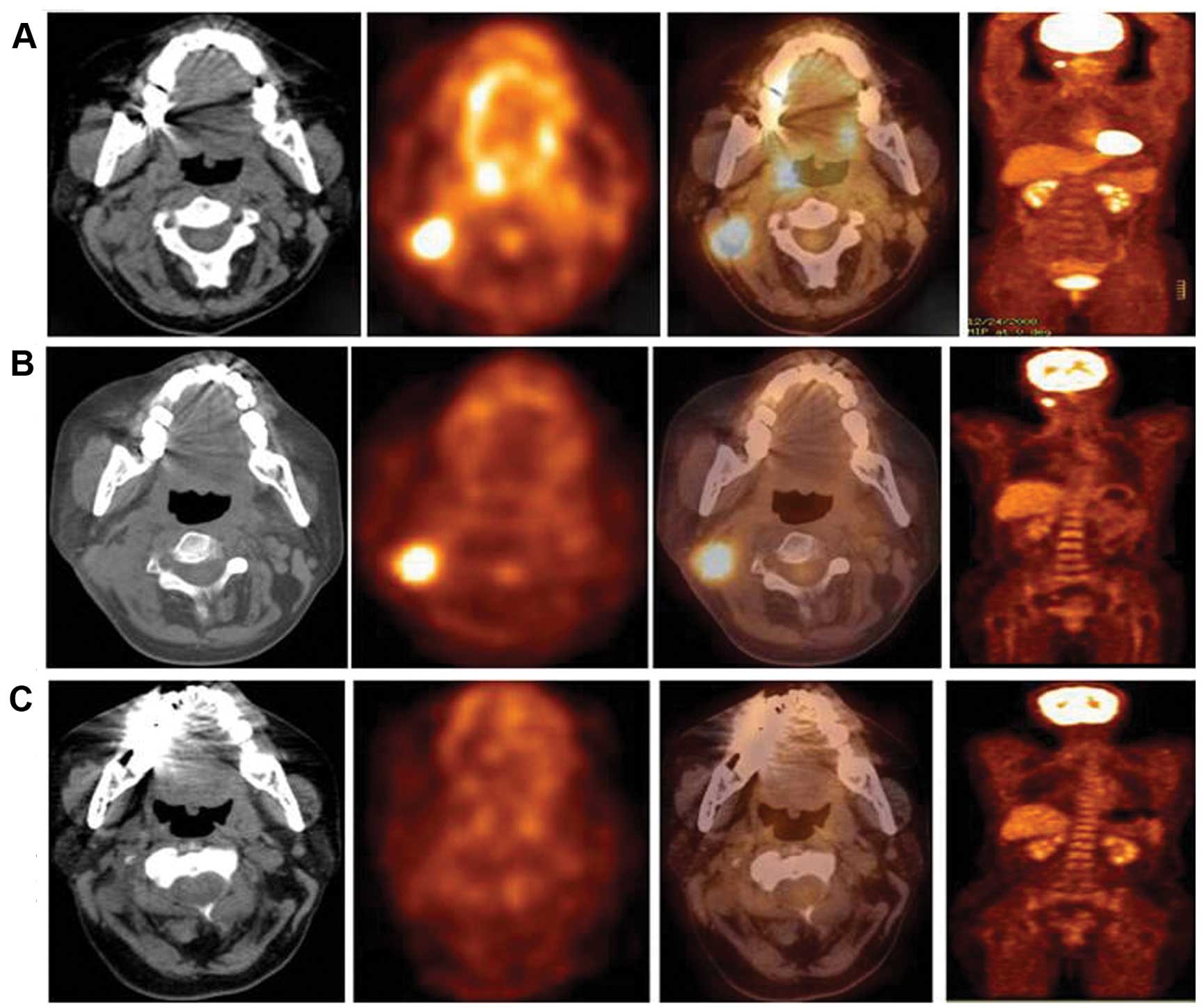Clinical value of 18F‑fluorodeoxyglucose positron emission tomography/computed tomography in evaluating relapsed and refractory nasopharyngeal carcinoma: A case report
- Authors:
- Zejun Lu
- Xiangfei Zhao
- Henghu Fang
- Sudong Wu
- Juyi Wen
- Xinhong Zhang
- Jingbo Kang
View Affiliations
Affiliations: Department of Radiation Oncology, Naval General Hospital of People's Liberation Army, Beijing 100048, P.R. China
- Published online on: February 9, 2015 https://doi.org/10.3892/mco.2015.507
-
Pages:
581-583
Metrics: Total
Views: 0 (Spandidos Publications: | PMC Statistics: )
Metrics: Total PDF Downloads: 0 (Spandidos Publications: | PMC Statistics: )
This article is mentioned in:
Abstract
For patients with locoregionally advanced nasopharyngeal carcinoma (NPC), radiotherapy, chemotherapy and even targeted therapy are widely accepted treatments. These treatments, although they mostly achieve locoregional tumor control, they may also be associated with complex post‑treatment changes, such as edema, loss of tissue planes, fibrosis, mucositis and scarring, which may interfere with the detection of local recurrence and the response to therapy. However, timely detection is crucial for deciding whether treatment modification or discontinuation is required. This is the case report of a 51‑year‑old nasopharyngeal carcinoma patient with cervical nodal metastases (CNM). Following radiotherapy, chemotherapy and targeted therapy, multislice spiral enhanced computed tomography (CT), enhanced magnetic resonance imaging (MRI) and 18F‑fluorodeoxyglucose (FDG) positron emission tomography (PET)̸CT of the neck were performed to compare the extent of the CNM. The enhanced CT and MRI images were unremarkable, whereas the 18F‑FDG PET̸CT images revealed the exact recurrence or remission. Therefore, 18F‑FDG PET/CT exhibits a better sensitivity and specificity for evaluating the response to combined treatment compared to CT and/or MRI.
View References
|
1
|
Nuñez RF, Yeung HW and Chisin R:
Fluorine-18 FDG positron emission tomography in advanced
nasopharyngeal carcinoma. Clin Nucl Med. 25:731–733. 2000.
View Article : Google Scholar : PubMed/NCBI
|
|
2
|
Peng F, Rabkin G and Muzik O: Use of
2-deoxy-2-[F-18]-fluoro-D-glucose positron emission tomography to
monitor therapeutic response by rhabdomyosarcoma in children:
report of a retrospective case study. Clin Nucl Med. 31:394–397.
2006. View Article : Google Scholar : PubMed/NCBI
|
|
3
|
Klabbers BM, Lammertsma AA and Slotman BJ:
The value of positron emission tomography for monitoring response
to radiotherapy in head and neck cancer. Mol Imaging Biol.
5:257–270. 2003. View Article : Google Scholar : PubMed/NCBI
|
|
4
|
Mostafa E, Nasar MN, Rabie NA, et al:
Induction chemotherapy with paclitaxel and cisplatin, followed by
concomitant cisplatin and radiotherapy for the treatment of locally
advanced nasopharyngeal carcinoma. J Egypt Natl Canc Inst.
18:348–356. 2006.PubMed/NCBI
|
|
5
|
Kim YI, Han MH, Cha SH, et al:
Nasopharyngeal carcinoma: posttreatment changes of imaging
findings. Am J Otolaryngol. 24:224–230. 2003. View Article : Google Scholar : PubMed/NCBI
|
|
6
|
King AD, Ma BB, Yau YY, et al: The impact
of 18F-FDG PET/CT on assessment of nasopharyngeal carcinoma at
diagnosis. Br J Radiol. 81:291–298. 2008. View Article : Google Scholar : PubMed/NCBI
|
|
7
|
de Bondt RB, Nelemans PJ, Hofman PA, et
al: Detection of lymph node metastases in head and neck cancer: a
meta-analysis comparing US, USgFNAC, CT and MR imaging. Eur J
Radiol. 64:266–272. 2007. View Article : Google Scholar : PubMed/NCBI
|
|
8
|
Osmany S, Padhy AK and Ng DC: Detection of
thyroid metastases from nasopharyngeal carcinoma with F-18 FDG
PET/CT. Clin Nucl Med. 33:224–225. 2008. View Article : Google Scholar : PubMed/NCBI
|
|
9
|
Ong SC, Schöder H, Lee NY, et al: Clinical
utility of 18F-FDG PET/CT in assessing the neck after concurrent
chemoradiotherapy for locoregional advanced head and neck cancer. J
Nucl Med. 49:532–540. 2008. View Article : Google Scholar : PubMed/NCBI
|
|
10
|
Yao M, Smith RB, Hoffman HT, et al:
Clinical significance of postradiotherapy [18F]-fluorodeoxyglucose
positron emission tomography imaging in management of head-and-neck
cancer-a long-term outcome report. Int J Radiat Oncol Biol Phys.
74:9–14. 2009. View Article : Google Scholar : PubMed/NCBI
|











